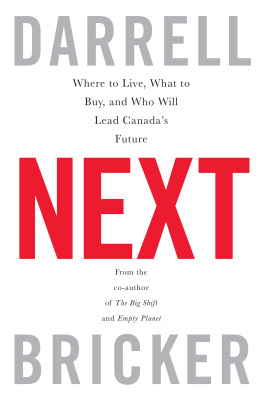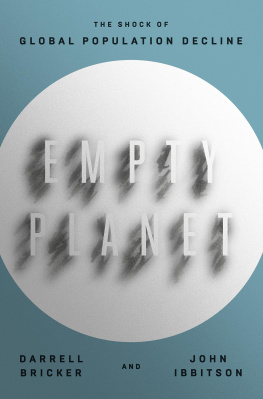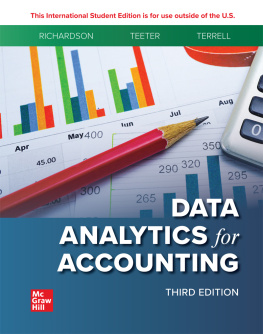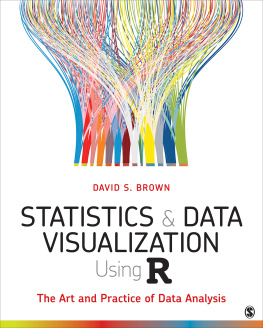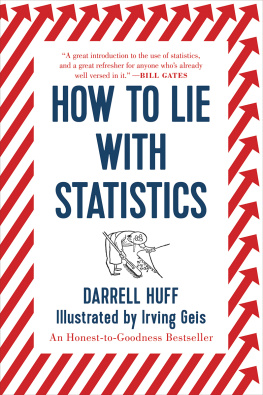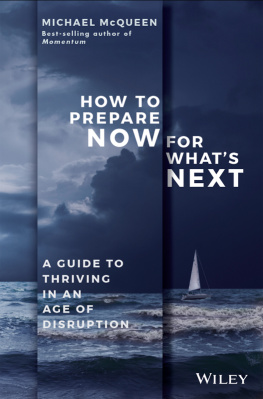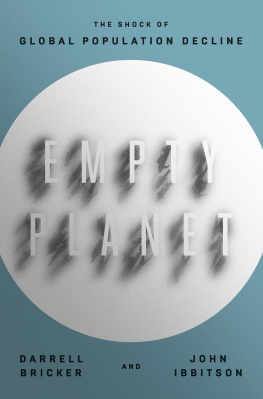Contents
Guide
To Nina and Emily, my little family.
Without you, there is no me.
Contents
Shifting Demand
Canadas demography is changing radically and rapidly, opening a gap, which will soon be a gulf, between the new demand and the old supply. Anyone who is in the business of supplying goods and services to Canadians, ranging from the CEOs of our biggest banks to the operators of small-town dollar stores, needs to understand and deal with these changes to be successful in what I refer to as New Canada.
The good news is these changes arent bolts out of the blue, and they certainly arent random. They are reasonably predictable. Why? Because as someone once said, two-thirds of everything can be explained by demographics. Sure, this might be a bit of an overstatement. But understanding demographic change is critical to understanding Canadas future. Knowing the basic facts of the Canadian populationour age patterns, how we work and with whom, and where we will live and work, as well as where were coming from and where were going totells us a lot about the future of Canada. This knowledge wont fill in all the blanks, because demography isnt destiny. But it represents a significant set of facts that any person dealing with Canadians should be well acquainted with.
Im a big fan of understanding the nature and direction of demographic change. Thats why I lean on emerging demographic realities to tell the story about Canadas future. Demographics represent the essence of any population. Before you look at what people think (opinions) or what they might do (behaviours), its important to understand who they are and who they are becoming.
Whats especially useful about demography is that it is precise, objective, and projectable. Demographics are facts, not opinions, and theyre not new. In Canada, we can trace our first regular census back to 1871. Depending on how much you want to stretch things, there was a census in New France as far back as 1666. But the twentieth century was truly Canadas first measured period, and we continue to build on the wealth of information collected every day. For the past hundred years, many aspects of Canadian society have been and are being constantly and thoroughly measured. This includes who we are, how we behave, and what we think.
Whats especially useful about demographic data is not what they say about our past or even our present, but what they reveal about our future. Like satellite reports showing future weather patterns, data about people show us our future marketplace patterns. Demographic change is observable from a distance. And it is very, very difficult to alter a demographic trend once it gets rolling. Meaningful demographic changes tend to be locked in for a quarter century or more. Opinions and behaviours, on the other hand, can change quickly depending on the course of events. Therefore, demographics are especially useful when considering medium- to longer-term scenarios such as the ones Ill present in this book.
Turning Data into Advice
I always have datalots of data. Data are facts, and facts have power. The Economist magazine has gone so far as to declare that the worlds most valuable resource is no longer oil, but data.
But while data is a great place to start, it doesnt tell the whole story. Theres tragedy and romance in the data, and its my job to find it and relay it. But the narrative can be elusive. And even if I find it, if I dont tell it right, it can devolve into a spray of useless numbers that the audience quickly forgets. You know, just like that high-school math class you might have hated.
Fortunately, after three decades as a pollster, social researcher, strategic advisor, speaker, and writer, Ive learned how to tell a pretty effective story with data. Thats a bold statement, I know. But as one of my colleagues likes to remind me, the marketplace always decides. You arent invited into the room if you cant deliver.
I also have the best day job any data geek can have. Im the Global CEO of Ipsos Public Affairs, the worlds leading social and public opinion research company. We have people on the ground in thirty-eight countries and work for clients all over the world. Ipsos Public Affairs is part of Ipsos, the worlds third-largest market research company. Ipsos is based in Paris, France. I just happen to be Canadian and choose to live in Canada. Frankly, I cant imagine living anywhere else. Canada will always be my home (but its great to hang out in Paris too).
Being part of an amazing organization like Ipsos gives me access to an incredible array of data, but also to some of the worlds most insightful social scientists. I learn from them every day. While Ipsos is a global research company, it is also the biggest and best-known research company in Canada. For someone with my skills and interests, being at Ipsos is the perfect match.
What do we do at Ipsos? At the most basic level, our clients hire us to tell them data-driven stories that inspire them to change. For private-sector clients, change means expanding their base of loyal customers. For public-sector clients, it means happier citizens. For political clients, it means more supportive voters. In the end, though, its all about advice. Numbers are just the tool for coming up with the advice. Over the past thirty years, I have had the privilege of advising prime ministers, premiers, mayors, and countless cabinet ministers and other public officials on public issues. Ive also advised many corporations and industries confronted with big consumer challenges in Canada and around the world.
Declining Birth Rates
To prepare for Canadas future, the first bits of data we need to understand concern our national fertility. The average number of children a Canadian woman gives birth to in her lifetimethat is, Canadas birth rateis currently 1.5. To maintain a steady state population that neither grows nor shrinks, a country needs an overall birth rate of at least 2.1. Thats one child born to replace each of their parents, and a little bit extra to compensate for those of us who cant or decide not to have kids. With a birth rate of only 1.5, we will eventually have more people dying in Canada every day than are being born.
Canada is half a baby short of the number necessary to maintain its population without immigration. This wasnt always the case. Back in the early 1960s, which corresponds to the end of Canadas Baby Boom, our birth rate was nearly 4.0. We had natural population growth back then, without immigration.
What changed with our national fertility? While the explanation we often jump to is the mainstreaming of the birth control pill, its more complicated than that. What really happened is a good news story about the empowerment of Canadian women: taking control of their education and workforce participation; deciding to move to the city; deciding to have smaller families and to start them later (a decade later than the Boomers). What has reduced Canadas birth rate is the choices Canadiansespecially Canadian womenare now making about the families they want to have and how they want to live their lives. The birth control pill, long heralded as causing the decline of birth rates, just made these choices easier.
You dont have to take my word for it. Look at your own family. How many children did your grandparents have? What about your parents? What about you? And if your children are old enough to start their own families, how many children do you expect them to have? When you look at the overall picture, I expect that your familys generations have gotten smaller over time. If your familys fertility was drawn as a graph, it would likely look like a funnel: wider at the top, narrower at the bottom, as each progressive generations birth rate decreased in size. Sure, there are always exceptions. But the power of demography is in understanding the bigger trends, not in getting distracted by the small stuff.
Next page
